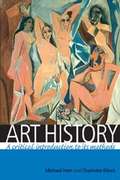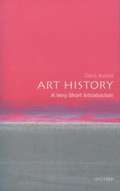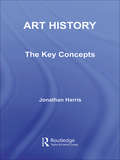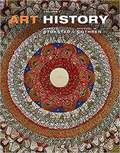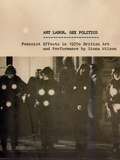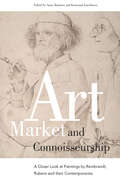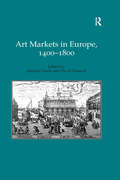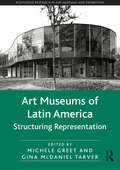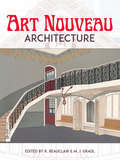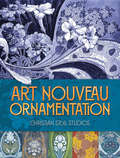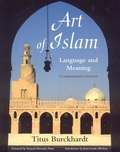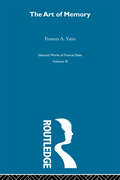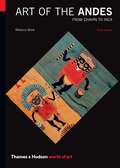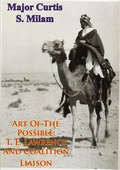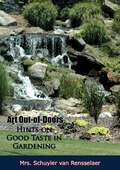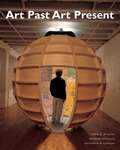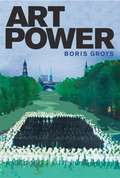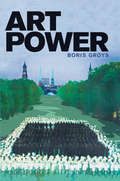- Table View
- List View
Art History: A Critical Introduction to Its Methods
by Michael Hatt Charlotte KlonkThis book provides a lively and stimulating introduction to methodological debates within art history. Offering a lucid account of approaches from Hegel to post-colonialism, the book provides a sense of art history's history as a discipline from its emergence in the late-eighteenth century to contemporary debates. By explaining the underlying philosophical and political assumptions behind each method, along with clear examples of how these are brought to bear on visual and historical analysis, the authors show that an adherence to a certain method is, in effect, a commitment to a set of beliefs and values. The book makes a strong case for the vitality of the discipline and its methodological centrality to new fields such as visual culture. This book will be of enormous value to undergraduate and graduate students, and also makes its own contributions to ongoing scholarly debates about theory and method.
Art History: A Very Short Introduction
by Dana ArnoldThis clear and concise new introduction examines all the major debates and issues using a wide range of well-known examples. It discusses the challenge of using verbal and written language to analyse a visual form. Dana Arnold also examines the many different ways of writing about art, and the changing boundaries of the subject of art history. Topics covered include the canon of Art History, the role of the gallery, 'blockbuster' exhibitions, the emergence of social histories of art (Feminist Art History or Queer Art History, for example), the impact of photography, and the development of Art History using artefacts such as the altarpiece, the portrait, or pornography, to explore social and cultural issues such as consumption, taste, religion, and politics. Importantly, this book explains how the traditional emphasis on periods and styles originates in western art production and can obscure other critical approaches, as well as art from non western cultures.
Art History: Teach Yourself Ebook (The Basics)
by Grant Pooke Diana NewallArt History: The Basics is a concise and accessible introduction for the general reader and the undergraduate approaching the history of art for the first time at college or university. It will give you answers to questions like: What is art and art history? What are the main methodologies used to understand art? How have ideas about form, sex and gender shaped representation? What connects art with psychoanalysis, semiotics and Marxism? How are globalization and postmodernism changing art and art history? Each chapter introduces key ideas, issues and debates in art history, including information on relevant websites and image archives. Fully illustrated with an international range of artistic examples, Art History: The Basics also includes helpful subject summaries, further ideas for reading in each chapter, and a useful glossary for easy reference.
Art History: The Basics (The Basics)
by Grant Pooke Diana NewallNow in its second edition, this volume is an accessible introduction to the history of art. Using an international range of examples, it provides the reader with a toolkit of concepts, ideas and methods relevant to understanding art history. This new edition is fully updated with colour illustrations, increased coverage of non-western art and extended discussions of contemporary art theory. It introduces key ideas, issues and debates, exploring questions such as: What is art and what is meant by art history? What approaches and methodologies are used to interpret and evaluate art? How have ideas regarding medium, gender, identity and difference informed representation? What perspectives can psychoanalysis, semiotics and social art histories bring to the study of the discipline? How are the processes of postcolonialism, decolonisation and globalisation changing approaches to art history? Complete with helpful subject summaries, a glossary, suggestions for future reading and guidance on relevant image archives, this book is an ideal starting point for anyone studying art history as well as general readers with an interest in the subject.
Art History: The Key Concepts (Routledge Key Guides)
by Jonathan HarrisArt History: The Key Concepts is a systematic, reliable and accessible reference guide to the disciplines of art history and visual culture. Containing entries on over 200 terms integral to the historical and theoretical study of art, design and culture in general, it is an indispensable source of knowledge for all students, scholars and teachers. Covering the development, present status and future direction of art history, entries span a wide variety of terms and concepts such as abstract expressionism, epoch, hybridity, semiology and zeitgeist. Key features include: a user-friendly A-Z format fully cross-referenced entries suggestions for further reading. Engaging and insightful, as well as easy to follow and use, Art History: The Key Concepts builds a radical intellectual synthesis for understanding and teaching art, art history and visual culture.
Art History: Volume 1
by Marilyn Stokstad Michael W. CothrenArt History brings the history of art to life for a new generation of students. It is global in scope, inclusive in its coverage, and warm and welcoming in tone. The guiding vision of Art History is that the teaching of art history survey courses should be filled with equal delight, enjoyment, and serious learning, while fostering an enthusiastic and educated public for the visual arts. The Sixth Edition has been revised to reflect new discoveries, recent research, and fresh interpretive perspectives, as well as to address the changing needs of both students and educators. Art History, Sixth Edition is also available via Revel™, an interactive learning environment that enables students to read, practice, and study in one continuous experience.
Art In The Age Of Mass Media
by John WalkerCan fine art survive in an age of mass media? If so, in what forms and to what purpose? And can radical art still play a critical role in today's divided world? These are the questions addressed in the Art in the Age of Mass Media, as John Walker examines the fascinating relationship between art and mass media, and the myriad interactions between h
Art Is Not What You Think It Is (Wiley-Blackwell Manifestos #73)
by Donald Preziosi Claire FaragoArt Is Not What You Think It Is utilizes original research to present a series of critical incursions into the current state of debate on the idea of art, making manifest what has been largely missing or unsaid in those discussions. Links museology, history, theory, and criticism to the realities of contemporary social conditions and shows how they have structurally functioned in a variety of contexts Deals with divisive and controversial problems such as blasphemy and idolatry, and the problem of artistic truth Addresses relations between European notions about art and artifice and those developed in other and especially indigenous cultural traditions
Art Labor, Sex Politics: Feminist Effects in 1970s British Art and Performance
by Siona WilsonContrary to critics who have called it the &“undecade,&” the 1970s were a time of risky, innovative art—and nowhere more so than in Britain, where the forces of feminism and labor politics merged in a radical new aesthetic. In Art Labor, Sex Politics Siona Wilson investigates the charged relationship of sex and labor politics as it played out in the making of feminist art in 1970s Britain. Her sustained exploration of works of experimental film, installation, performance, and photography maps the intersection of feminist and leftist projects in the artistic practices of this heady period.Collective practice, grassroots activism, and iconoclastic challenges to society&’s sexual norms are all fundamental elements of this theoretically informed history. The book provides fresh assessments of key feminist figures and introduces readers to less widely known artists such as Jo Spence and controversial groups like COUM Transmissions. Wilson&’s interpretations of two of the best-known (and infamous) exhibitions of feminist art—Mary Kelly&’s Post-Partum Document and COUM Transmissions&’ Prostitution—supply a historical context that reveals these works anew. Together these analyses demonstrate that feminist attention to sexual difference, sex, and psychic formation reconfigures received categories of labor and politics.How—and how much—do sexual politics transform our approach to aesthetic debates? What effect do the tropes of sexual difference and labor have on the very conception of the political within cultural practice? These are the questions that animate Art Labor, Sex Politics as it illuminates an intense and influential decade of intellectual and artistic experimentation.
Art Market and Connoisseurship: A Closer Look at Paintings by Rembrandt, Rubens and Their Contemporaries (Amsterdam Studies in the Dutch Golden Age)
by Anna Tummers Koenraad JonckheereThe question whether or not seventeenth century painters such as Rembrandt and Rubens created the paintings which were later sold under their names, has caused many a heated debate. Much is still unknown about the ways in which paintings were produced, assessed, priced, and marketed. For example, did contemporary connoisseurs expect masters such as Rembrandt to paint their works entirely by their own hand? Who was credited with the ability to assess paintings? How did a painting’s price relate to its quality? And how did connoisseurship change as the art market became increasingly complex? The contributors to this essential volume trace the evolution of connoisseurship in the booming art market of the seventeenth- and eighteenth centuries. Among them are the renowned Golden Age scholars Eric Jan Sluijter, Hans Van Miegroet and Neil De Marchi. It is not to be missed by anyone with an interest in the Old Masters and the early modern art market.
Art Markets in Europe, 1400–1800
by Michael North David OrmrodThe reinvention of art-history during the 1980s has provided a serious challenge to the earlier formalist and connoisseurial approaches to the discipline, in ways which can only help economic and social historians in the current drive to study past societies in terms of what they consumed, produced, perceived and imagined. This group of essays focuses on three main issues: the demand for art, including the range of art objects purchased by various social groups; the conditions of artistic creativity and communication between different production centres and artistic millieux; and the emergence of art markets which served to link the first two phenomena. The work draws on new research by art historians and economic and social historians from Europe and the United States, and covers the period from the late Middle Ages to the early nineteenth century.
Art Museums of Latin America: Structuring Representation (Routledge Research in Art Museums and Exhibitions)
by Michele Greet Gina McDaniel TarverSince the late nineteenth century, art museums have played crucial social, political, and economic roles throughout Latin America because of the ways that they structure representation. By means of their architecture, collections, exhibitions, and curatorial practices, Latin American art museums have crafted representations of communities, including nation states, and promoted particular group ideologies. This collection of essays, arranged in thematic sections, will examine the varying and complex functions of art museums in Latin America: as nation-building institutions and instruments of state cultural politics; as foci for the promotion of Latin American modernities and modernisms; as sites of mediation between local and international, private and public interests; as organizations that negotiate cultural construction within the Latin American diaspora and shape constructs of Latin America and its nations; and as venues for the contestation of elitist and Eurocentric notions of culture and the realization of cultural diversity rooted in multiethnic environments.
Art Music Activism: Aesthetics and Politics in 1930s New York City (Music in American Life)
by Maria Cristina FavaSurrounded by the widespread misery of the Depression, left-leaning classical music composers sought a musical language that both engaged the masses and gave voice to their concerns. Maria Cristina Fava explores the rich creative milieu shaped by artists dedicated to using music and theater to advance the promotion, circulation, and acceptance of leftist ideas in 1930s New York City. Despite tensions between aesthetic and pragmatic goals, the people and groups produced works at the center of the decade’s sociopolitical and cultural life. Fava looks at the Composers’ Collective of New York and its work on proletarian music and workers’ songs before turning to the blend of experimentation and vernacular idioms that shaped the political use of music within the American Worker’s Theater Movement. Fava then reveals how composers and theater practitioners from these two groups achieved prominence within endeavors promoted by the Works Project Administration. Fava’s history teases out fascinating details from performances and offstage activity attached to works by composers such as Marc Blitzstein, Charles Seeger, Ruth Crawford Seeger, Elie Siegmeister, and Harold Rome. Endeavors encouraged avant-garde experimentation while nurturing innovations friendly to modernist approaches and an interest in non-western music. Blitzstein’s The Cradle Will Rock offered a memorable example that found popular success, but while the piece achieved its goals, it became so wrapped up in myths surrounding workers’ theater that critics overlooked Blitzstein’s musical ingenuity. Provocative and original, Art Music Activism considers how innovative classical composers of the 1930s balanced creative aims with experimentation, accessible content, and a sociopolitical message to create socially meaningful works.
Art Nouveau Architecture
by R. Beauclair M. J. GradlPublished in Paris in 1902, these rare plates offer a unique source of details of the era's "modern" architecture. The 58 full-color images originally appeared in a short-lived periodical from the height of the Art Nouveau period. They provide an authentic source of information on how Art Nouveau influenced architectural design in the early twentieth century. Illustrations include windows, doorways, joists, railings, stairways, chimneys, ornamental woodwork, exterior decoration, elaborate ironwork, and much more. Additional plates depict interior and exterior views of these architectural elements in actual and planned buildings and rooms designed by architects of the period. Brief captions supply details for each plate. This treasury of rare illustrations and information represents a valuable resource for students of art history and the history of architecture as well as for architects and designers interested in Art Nouveau.
Art Nouveau Ornamentation
by Christian StollThis splendid source of authentic Art Nouveau designs presents more than 90 breathtaking plates, ranging from single to full color, selected from rare originals of a renowned German studio's stock portfolios.
Art Of Islam: Language And Meaning
by Titus BurckhardtKnown as an expert on Islam, Sufism, and Islamic arts & crafts, Burckhardt presents in-depth analyses of seminal examples of Islamic architecture, from Spain and Morocco to Persia and India. He examines Koranic calligraphy and illumination, arabesque, carpets and rugs, Persian miniatures, and much more while making illuminating comparisons with Christian, Hindu, and Buddhist art. Beautifully illustrated in color, this masterpiece is presented in a revised, commemorative edition containing 285 new illustrations and a new Introduction.
Art Of Memory
by F A YatesFirst Published in 1999. Routledge is an imprint of Taylor & Francis, an informa company.
Art Of The Andes: From Chavín To Inca
by Rebecca StoneThis wide-ranging survey has established itself as the best singlevolume introduction to Andean art and architecture, and is an essential guide to pre-Columbian Peru, Ecuador, and Bolivia for the general reader, student, traveler, and artist alike. Describing the strikingly varied artistic achievements of the Chavín, Paracas, Moche, Nasca, Chimu, and Inca cultures, among others, Rebecca Stone has rewritten and expanded the text throughout, touching on many of the recent discoveries and advances in the field. <p><p> Throughout this fully revised third edition, Stone demonstrates how the Andean peoples adapted and refined their aesthetic response to a formidable and demanding environment and explored the interface between the terrestrial and the otherworldly according to the value they placed on shamanic religious experience.
Art Of The Possible: T. E. Lawrence And Coalition Liaison [Illustrated Edition]
by Major Curtis S. MilamIncludes World War One In The Desert Illustration Pack- 115 photos/illustrations and 19 maps spanning the Desert campaigns 1914-1918.Coalition warfare has been, and will continue to be, a matter of course for the U.S. military. Developing and maintaining coalitions of politically and militarily diverse members is, at its most elemental level, a matter of human relationships--the person-to-person give and take that characterizes all human endeavor. It is often complex, inexact, and tedious, perhaps more art than science. The frustration encountered by policymakers and military professionals alike argues strongly for an earnest examination of the personal characteristics and professional principles used by successful coalition builders, liaisons, and advisors. This paper examines the contributions made by T.E. Lawrence to the art of coalition liaison during his service as the British advisor to the Arabs during World War I. Specifically, it identifies the personal characteristics that helped Lawrence work so effectively with the Arabs, as well as the professional principles that guided his actions as he helped form the coalition of Arab tribes and the alliance between those tribes and Britain.
Art Out-of-Doors: Hints on Good Taste in Gardening
by Mrs Schuyler Van RensselaerAn explanation of the essential principles of landscape gardening so that readers from all walks of life may admire the beauty of a well-designed formal garden.Landscape gardening as an art, in its practical application to the beautifying of country places, is the subject of a book by Mrs. Van Rensselaer, who writes with thorough knowledge and with fresh enthusiasm. She gives information and hints in abundance relating to the treatment of grounds, roads and paths, piazzas, pattern beds, trees and shrubs, etc., all animated by a fine artistic taste and a very genuine love of nature. It is very practical and helpful, and is written in the same agreeable manner that characterizes all of Mrs. Van Rensselaer’s writings.CONTENTS: THE ART OF GARDENING—AIMS AND MEANS—HOME GROUNDS—CLOSE TO THE HOUSE—ROADS AND PATHS—PIAZZAS—WINTER BEAUTY—A WORD FOR ARCHITECTURE—PATTERN BEDS—FORMAL GARDENING—THE BEAUTY OF TREES—BOTANY AND BEAUTY—THE ARTIST—THE LOVE OF NATURE, ETC., ETC.
Art Past Art Present
by David G. Wilkins Bernard Schultz Katheryn M. LinduffAuthoritative and substantive-yet accessible-Art Past, Art Present, 6th edition looks at the historical and cultural contexts of art works and architecture around the world from prehistoric times to the 20th century. The authors recognized the need for an easy-to-use format that is accessible for both teachers and students. Each topic in Art Past, Art Present is organized into two- and four-page units and provides a clear and concise treatment of a select number of artworks, making it easier for instructors to focus on what is important and for students to learn.
Art Patronage and Conflicting Memories in Early Modern Iberia: The Marquises of Villena (Routledge Research in Art History)
by Maria Teresa Chicote PompaninThis volume investigates the mechanisms (artworks, treatises, and other forms of cultural patronage) that the Marquises of Villena and their opponents used to operate in the cultural battlefield of the time with the aim of understanding how their conflicting historical memories were constructed and manipulated. Concentrating on the late fifteenth and early sixteenth centuries, the book examines these two aristocrats and demonstrates that political tensions led not only to military conflicts during this period but also to conflicts fought on cultural grounds, through the promotion of artistic, religious, and literary programmes. Maria Teresa Chicote Pompanin investigates why the Marquises of Villena lost in both the military and cultural battlefields and explains how the negative historical memories forged by their opponents in the late fifteenth century managed to become the official historical truth that has remained unchallenged to this day. The book will be of interest to scholars working in art history, cultural history, medieval studies, Renaissance studies, Iberian studies, literary studies, and patronage studies.
Art Power
by Boris GroysGroys examines modern and contemporary art according to its ideological function. Art, Groys writes, is produced and brought before the public in two ways; as a commodity and as a tool of political propaganda.
Art Power (The\mit Press Ser.)
by Boris GroysA new book by Boris Groys acknowledges the problem and potential of art's complex relationship to power.Art has its own power in the world, and is as much a force in the power play of global politics today as it once was in the arena of cold war politics. Art, argues the distinguished theoretician Boris Groys, is hardly a powerless commodity subject to the art market's fiats of inclusion and exclusion. In Art Power, Groys examines modern and contemporary art according to its ideological function. Art, Groys writes, is produced and brought before the public in two ways—as a commodity and as a tool of political propaganda. In the contemporary art scene, very little attention is paid to the latter function.Arguing for the inclusion of politically motivated art in contemporary art discourse, Groys considers art produced under totalitarianism, Socialism, and post-Communism. He also considers today's mainstream Western art—which he finds behaving more and more according the norms of ideological propaganda: produced and exhibited for the masses at international exhibitions, biennials, and festivals. Contemporary art, Groys argues, demonstrates its power by appropriating the iconoclastic gestures directed against itself—by positioning itself simultaneously as an image and as a critique of the image. In Art Power, Groys examines this fundamental appropriation that produces the paradoxical object of the modern artwork.
Art Rebels: Race, Class, and Gender in the Art of Miles Davis and Martin Scorsese
by Paul LopesHow creative freedom, race, class, and gender shaped the rebellion of two visionary artistsPostwar America experienced an unprecedented flourishing of avant-garde and independent art. Across the arts, artists rebelled against traditional conventions, embracing a commitment to creative autonomy and personal vision never before witnessed in the United States. Paul Lopes calls this the Heroic Age of American Art, and identifies two artists—Miles Davis and Martin Scorsese—as two of its leading icons.In this compelling book, Lopes tells the story of how a pair of talented and outspoken art rebels defied prevailing conventions to elevate American jazz and film to unimagined critical heights. During the Heroic Age of American Art—where creative independence and the unrelenting pressures of success were constantly at odds—Davis and Scorsese became influential figures with such modern classics as Kind of Blue and Raging Bull. Their careers also reflected the conflicting ideals of, and contentious debates concerning, avant-garde and independent art during this period. In examining their art and public stories, Lopes also shows how their rebellions as artists were intimately linked to their racial and ethnic identities and how both artists adopted hypermasculine ideologies that exposed the problematic intersection of gender with their racial and ethnic identities as iconic art rebels.Art Rebels is the essential account of a new breed of artists who left an indelible mark on American culture in the second half of the twentieth century. It is an unforgettable portrait of two iconic artists who exemplified the complex interplay of the quest for artistic autonomy and the expression of social identity during the Heroic Age of American Art.
